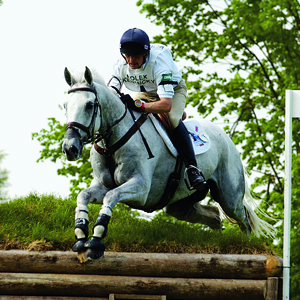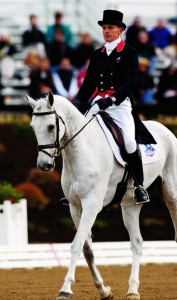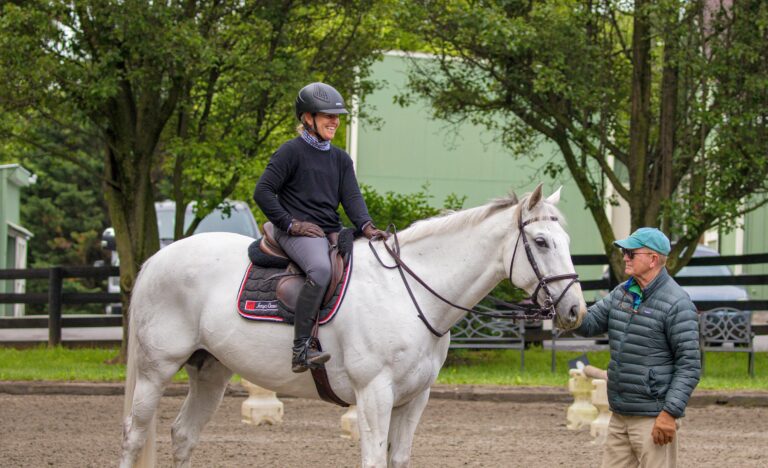Among eventing’s sometimes larger-than-life personalities, Leslie Law is about order and understatement. His performance at the 2003 Rolex Kentucky CCI**** with two horses, for instance, happened more or less under the publicity radar while three of his countrymen waged a high-profile tussle for the top placing. Yet, to use a favorite phrase of his, at the end of the day he’d ?

- compensated for a sticky start in the dressage phase with immaculate cross-country (two of only 16 double-clear trips among 55 entries) and careful show-jumping, finishing fifth?up from 15th after dressage?on worry-prone Shear L’Eau and 14th (up from 47th!) on volatile Diamond Hall Red.
- highlighted his cross-country coup by being the first and one of the few to take the direct route over the intimidating new double corners atop the Lexington Bank.
Whatever the riding level, there’s always more to learn about every horse, and Shear L’Eau’s foot-perfect trip in particular left Leslie “terribly excited” about the Irish-bred gray’s future. Against this background, an opportunity to spend time watching and talking with Leslie during the Rolex weekend became a look inside the thinking, as well as the riding talent, that go into his producing a consistently world-class performance.
‘Riding in a Ring Comes Later’
Leslie’s career?among whose highlights are team gold in the 2001 European Championships, team bronze in the 2002 World Equestrian Games, team silver at the 2000 Sydney Olympics and a Badminton second (2000) and third (2002)?got his start when he joined Britain’s Pony Club after learning to ride at age 10. He was “bitten by the bug” of eventing as a result of Pony Club activities, helped along by hunting-field mileage: a background he says many top British eventers share. “There’s probably no better grounding for riding cross-country than going out on a cold, wet, dark winter day, slopping around in mud, and learning to tackle whatever comes your way. Riding in a ring comes later.”
His parents provided plenty of support, though not the financial kind. “My father had a small transport business; my mother did the secretarial and book work. They couldn’t afford to buy me good horses, but they’ve been very good at encouraging me in what I wanted to do. It was up to me to find a solution to the problem of getting access to horses.”
To build a foundation in the sport, Leslie also needed access to quality training. “I think it’s very important in the early days to base yourself with a good professional rider and learn the trade?not only the riding aspects but the business side, how to work with owners?before you try to set out on your own.” An opportunity to do just that arose in 1983, when, near his parents’ home in Hay-on-Wye, 18-year-old Leslie happened to meet Virginia-based jumper rider Ian Silitch. Their conversation, comparing US and British systems, resulted in an invitation to come to Ian’s as a working student.
Thanks to Ian, Leslie spent “a very beneficial two years” in the States. “I learned to ride in a soft, forward seat with the horse’s rhythm, using very little hand. On the US hunter/jumper circuit, I wateched great riders like Rodney Jenkins, Leslie Burr [now Howard], Conrad Homfeld and Joe Fargis. I did very little competing, but I rode Ian’s horses?mostly American Thoroughbreds then?at home. Watching at ringside what he was doing so well helped me visualize what he was trying to educate me in. The more you can see how different people do different things, the more goes into your own riding ‘encyclopedia.'”
Other top British horsemen Leslie cites as influences include Christopher Bartle and jumper rider and trainer Rowland Fernyhough, from whom Leslie’s sponsor Jeremy Lawton of Shearwater Insurance brought Irish-bred Shear H2O?full older brother to his Rolex mount Shear L’Eau?as a 5-year-old in 1995. And, he says, “You can pick up an awful lot just by watching?for instance, watching what the good riders are doing as they work their horses in for dressage. Use your eyes; that’s for free.”
More than 15 years of hard work and watching have brought Leslie to his “very fortunate” situation, with five horses capable of competing at CCI**** level, others coming along at Advanced, and a group of 5 year olds just getting started.
A key part of Leslie’s role in the business is working with his horse’s owners. “I think you have to give owners fun. That means you have to give them time. They want to talk about their horses, which is why I make phone calls at the end of the day when I’ve been riding since 7 a.m. I want to ride’ I live for it, it’s what makes me tick?and they make it possible.”
Leslie also makes time to help eventing’s next generation. Riders who train with him include Kylie Roddy, who rode on the gold-medal British team for the 2001 European Young Rider Championships. In 2002, Leslie accepted an invitation to coach California’s North American Young Riders eventing team for the NAYRC, held in Illinois; he enjoyed the experience so much that he signed on to coach the same team for the 2003 Championship, in Bromont, Qu?bec.
‘All Horses are Different’
One of Leslie’s ruling principles is that “all horses are different, and you have to listen to each one.” He knows Shear L’Eau, for instance, as a “shy, inwardly reserved,” late-maturing horse with an unstinting work ethic. Shear L’Eau’s brother, Shear H2O, may not have quite Shear L’Eau’s “extravagance” of movement, Leslie says, but he’s a “brilliant” competitor who “produces very closely in the ring what he does in the warm-up, which is very important.”

In contrast, Diamond Hill Red tends to promise all in the warm-up, only to lose performance in the ring. Red’s previous rider, New Zealand Olympian Mark Todd, once described him as “a bit fragile in temperament.”
Leslie’s warm-up with Shear L’Eau for their Thursday-morning dressage test is a study in quiet reassurance, beginning with prolonged, almost leisurely leg-yielding and half-pass at walk. “Shear L’Eau can be a little fussy in the contact with my hand, so we start with leg-yielding to get him bending his body and creating more engagement behind. Then he rounds his back and takes the contact better, going forward to it, rather than my taking back. He’s comfortable in that exercise and finds security in it. If he starts to get worried about something he’s finding difficult later in the warm-up, I can always go back to that basic work; it’s like taking a nervous child by the hand.”
When they move on to rot work, most or all of it is in rising trot because Shear L’Eau’s trot is “bouncy to sit to” and he tends to tighten his back against a sitting rider. “By staying in rising trot, I can keep Shear L’Eau soft and allow his back to come up and be rounder. I might do more sitting trot when working at home, but in competition, my goal is to enable him to stay soft for the eight minutes of the test.”
After their relaxed warm-up, Shear L’Eau puts in a calm, obedient test. Its only misstep, heartbreakingly near the end, is a muffed flying change on the final canter across the diagonal. The moment of disharmony?mysterious, because all of the earlier canter work was elegant and accurate?is costly; their score of 51.2 puts them near but not in the top tier of competitors with 50 or fewer penalties. “Horses don’t have the opportunity to tell us how they’re feeling on a particular day,” Leslie says with a rueful smile. “We have to try to work it out. But it would make it a lot easier if he could tell me what he was feeling at the end of that test!”
‘A Great Experience’ for the Horses
By this time, Leslie is mentally switching gears for Saturday’s cross country. He’s walked Michael Etherington-Smith’s redesigned course (its direction reversed for the first time in 10 years), and he likes it. “It looks to me as if it will flow even a little better than in 2002.”
Asked what are the toughest challenges, he fingers questions that will turn out to be decisive: Early on, there’s the loop from the “coffin” jump at Fence 7/8AB (Rails/Ditch/Rails) to Fence 9/10AB (Maker’s Mark Water) with its maximum-height bounce into water. “If you don’t get a good ride at the coffin, you have no time to get your horse up and going before you’ve got another big question.” On the back side of the rolling course, he pinpoints 17ABCDE (The Hollow), followed immediately by three related jumps in a curving line at 18ABC (The Farmyard) at the bottom of the hill. “You’ve got two lots of combinations; it could be influential.” Finally, there’s the Lexington Bank, this year a late-in-the-course question (Fence 28) with artful placement of rocks eliminating what would have been the easiest line to two corners at the top of the slope., “Horses will be getting tired and long in their gallop, and you want your horse to come there with its hocks underneath it, trying to create some energy without too much speed.”
Asked to compare this course with Britain’s Badminton and Burghley, Leslie says it’s “an honest four-star course. ? The Rolex cross-country course is every bit as difficult. But Badminton, especially, is an amazing venue where it’s very difficult to compete because of the crowds. As a rider, you walk out to the courtyard of the Duke of Beaufort’s old hunt stables, where we all get stabled, and you hear the hooves on the tarmac as the horses come under the clock tower, and then you see the sea of people up in the park?it makes you tingle, really. The crowds at Rolex are more like what we would find at our three-star events.”
Repeated exposure to Badminton’s “buzz and atmosphere” since his first run there, on Welton Apollo in 1988, doubtless contributes to Leslie’s cool, composed performance on a day that is sunny and temperate with perfect footing. Only the third on course, he and Shear L’Eau excite spectators at The Bank by taking the risky direct line over the double corners?and making it look easy. The pair finishes well within the 11-minutes, 3-seconds time allowed.
“I wasn’t sure how the time would ride,” Leslie says later. “Going so early, I had to ride the course as I’d walked it. And Shear L’Eau is very trustworthy on lines; at narrow fences he looks for a fence, not for a way out.”
As the day progresses, Leslie proves to be one of only a handful of riders taking the direct route over The Bank; even he elects the long route there with Diamond Hall Red. “It was clear by then that you could get the time by going the long way; if I just upped the pace a little in different areas of the course, I could play it safe there and still get inside the time.” The plan works, for another double clear.
At day’s end, stops and glance-offs at the course’s technical questions have penalized many riders, and Leslie has edged up to eighth place with Shear L’Eau and 21st with Diamond Hall Red. Although delighted with two flawless runs, his first thought is for the day’s effect on his horses. “I think they thoroughly enjoyed it,” he beams. “They felt very comfortable galloping, and it was a great experience for them, which is so important.” Another plus: His enhanced awareness of Shear L’Eau’s potential. “After this cross country, he’s looking like an extremely impressive horse.
This article originally appeared in the August 2003 issue of Practical Horseman magazine.










